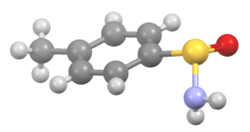Chemistry:Sulfinamide
In organosulfur chemistry, sulfinamide is a functional group with the structure R–S(=O)–NR
2 (where R = alkyl or aryl).[1] This functionality is composed of a sulfur-carbon (S–C) and sulfur-nitrogen (S–N) single bonds, as well as a sulfur-oxygen double bond (S=O), resulting in a tetravalent sulfur centre (in resonance with its zwitterionic form). As a non-bonding electron pair is also present on the sulfur, these compounds are also chiral. They are sometimes referred to as S-chiral sulfinamides. Sulfinamides are amides of sulfinic acid (R–S(O)OH).

Structure
Sulfinamides do not undergo inversion. They can therefore be synthesised and/or isolated in enantiopure forms. This has led to their use as chiral ammonia equivalents and more broadly as chiral auxiliaries.
Synthesis
Sulfinamides are traditionally produced by the reaction of sulfinyl chlorides with primary or secondary amines.[1] They also arise by the addition of Grignard reagents to sulfinylamines, followed by protonation:
- RMgX + R'N=S=O → RS(O)(NR'MgX)
- RS(O)(NR'MgX) + H2O → RS(O)(NR'H) + "MgX(OH)"
Yet another route entails peracid-oxidation of sulfenylphthalimides, which gives sulfinylphthalimides.
Examples
A common sulfinamide is tert-butanesulfinamide (Ellman's sulfinamide), p-toluenesulfinamide (Davis' sulfinamide), and 2,4,6-trimethylbenzenesulfinamide.[3][4][5]
Sulfinamides arise in nature by the addition of nitroxyl (HNO) to thiols:[6]
- RSH + HNO → RS(O)NH2
References
- ↑ 1.0 1.1 J. G. Tillett (1981). "Sulphinamides". in Saul Patai. Sulphinic Acids, Esters and Derivatives. PATAI'S Chemistry of Functional Groups. John Wiley & Sons. doi:10.1002/9780470772270.ch7.
- ↑ Eccles, K. S.; Morrison, R. E.; Daly, C. A.; O'Mahony, G. E.; Maguire, A. R.; Lawrence, S. E. (2013). "Co-crystallisation Through Halogen Bonding with Racemic or Enantiopure Sulfinamides". CrystEngComm 15 (37): 7571–7575. doi:10.1039/C3CE40932E.
- ↑ Fanelli, D. L.; Szewczyk, J. M.; Zhang, Y.; Reddy, G. V.; Burns, D. M.; Davis, F. A. (2000). "SULFINIMINES (THIOOXIMINE S-OXIDES): ASYMMETRIC SYNTHESIS OF METHYL (R)-(+)-β-PHENYLALANATE FROM (S)-(+)-N-(BENZYLIDENE)-p-TOLUENESULFINAMIDE". Organic Syntheses 77: 50. http://www.orgsyn.org/demo.aspx?prep=v77p0050.; Collective Volume, 10, pp. 47
- ↑ Ruano, J. L.; Alemán, J.; Parra, A.; Cid, M. B. (2007). "PREPARATION OF N-p-TOLYLSULFONYL-(E)-1-PHENYLETHYLIDENEIMINE". Organic Syntheses 84: 129. http://www.orgsyn.org/demo.aspx?prep=v84p0129.
- ↑ Ramachandar, T.; Wu, Y.; Zhang, J.; Franklin A. Davis (2006). "(S)-(+)-2,4,6-TRIMETHYLBENZENESULFINAMIDE". Organic Syntheses 83: 131. http://www.orgsyn.org/demo.aspx?prep=v83p0131.
- ↑ Keceli, Gizem; Toscano, John P. (2014-06-10). "Reactivity of C-Terminal Cysteines with HNO" (in en). Biochemistry 53 (22): 3689–3698. doi:10.1021/bi500360x. ISSN 0006-2960. PMID 24869490. https://pubs.acs.org/doi/10.1021/bi500360x.
 |


